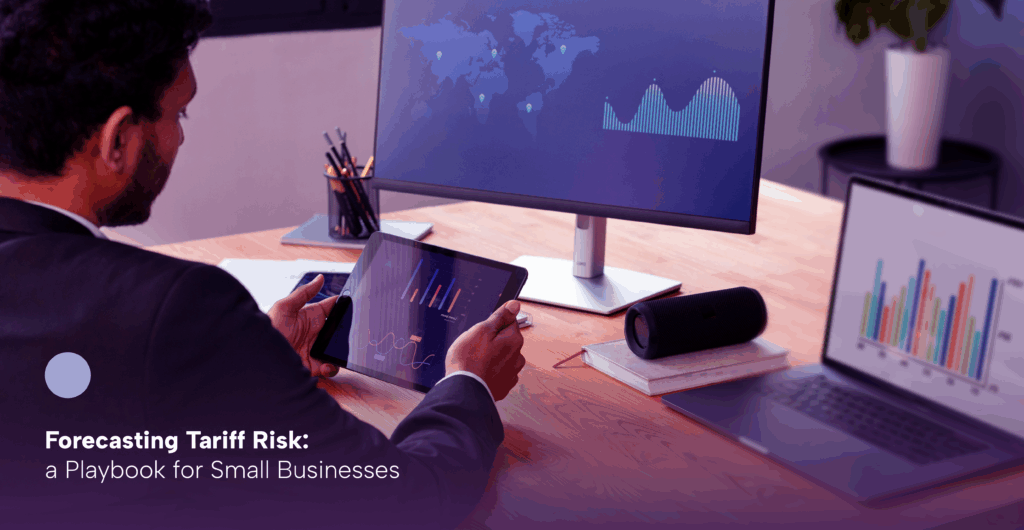
Forecasting Tariff Risk: a Playbook for Small Businesses
When a tariff headline hits the news, it can sound like distant policy noise. But for a small business that imports parts, equipment, or raw materials, that single headline can rewrite its cash-flow forecast overnight.
A 10% duty on steel might not mean much to a Wall Street analyst, but to a regional fabricator in Kansas or a farm-equipment dealer in Iowa, it’s the difference between a positive quarter and a covenant breach. Suddenly, what used to be a reliable borrower is calling to renegotiate terms, not because of bad management, but because of macro policy.
And that’s where banks feel it. For community banks and credit unions, tariff risk isn’t an abstract global story; it’s a local credit story that plays out across your borrowers’ income statements and balance sheets.
The question isn’t if tariffs will hit again (they will). The real question is how prepared your ALCO and credit teams are to see it coming.
What’s Changed and Why Small Businesses Feel It First
Tariffs have shifted again. In the latest Section 301 review, the U.S. Trade Representative finalized tariff modifications that notably increased rates on categories such as EVs and battery components, for example, EVs to 100% in 2024 and lithium-ion batteries to 25%. It’s a clear reminder that trade policy remains a moving target.
Who pays, in practice? Research on the 2018–2019 trade war showed that most of the tariff burden flowed through to U.S. importers and consumers rather than being absorbed overseas, meaning your borrower’s cost of goods sold rises directly.
What are the real-economy effects? According to a U.S. International Trade Commission study, Section 232 and 301 tariffs reduced imports of steel by about 24% and raised domestic steel prices by 2.4% on average. For small manufacturers, that kind of cost shock can erase margins and increase borrowing needs within a single quarter.
Why small businesses are exposed: They have thinner margins, fewer suppliers, and less pricing power. The U.S. Chamber of Commerce estimates that new tariffs amount to a $200 billion annual tax on small firms, disrupting supply chains and pricing structures.
Sentiment and uncertainty amplify the risk. The Federal Reserve’s research shows that tariff uncertainty spikes among small and medium businesses whenever new measures are announced, leading to delayed investment and weaker coverage ratios.
The ALCO Problem: Misestimation
Underestimating tariff pass-through or demand elasticity means overstating borrower cash flow, understating PD, and under-reserving. Overestimating them means withholding credit and tying up capital unnecessarily. The goal isn’t a single point forecast, it’s a distribution of outcomes that helps you plan under uncertainty.
A Forecasting Blueprint That Works
Think of tariff forecasting as four linked blocks. You can do this painstakingly in a spreadsheet, but it’s far more effective and repeatable in a tool like BARK
Block A: Translate Policy Into Cost Channels
- Map tariff-affected HS codes to borrower inputs.
- Estimate pass-through from tariff to landed cost (60–100%, depending on contracts).
- Account for customs and logistics friction that increase working capital needs.
Calibration hint: Use USITC’s published import and price effects to validate your assumptions.
Block B: Model Pricing and Demand Response
- Define what share of higher input costs can be passed through to customers.
- Estimate demand elasticity — how much sales volume drops as prices rise.
- Include time lags for contract renewals and catalog cycles.
Calibration hint: Empirical evidence from the 2018–2019 tariffs shows importers absorbed much of the cost, so assume conservative pass-through in most cases.
Block C: Push It Through the Financials
- Model gross margin compression and working-capital expansion.
- Simulate coverage ratios (DSCR, FCCR) and covenant headroom.
- Estimate credit metrics such as PD and LGD under stress.
Block D: Aggregate for ALCO
- Produce concentration heat maps by sector.
- Build a scenario-based ECL bridge (Base → Moderate → Severe).
- Quantify liquidity impact and contingency needs.
Two Real-World Mini Cases
Note: These numbers are illustrative, use them as templates calibrated to your borrower base.
Case 1: Midwest Metal Fabricator
- 25% of COGS comes from imported steel.
- A tariff shock increases landed steel costs by 10%; the borrower passes only half to clients.
- Sales volume dips by 2%.
- Result: gross margin compresses 120–180 bps; DSCR drops from 1.42× to 1.29× within six months.
Why it matters: U.S. ITC data confirm similar magnitude cost shocks for steel under Section 232.
Case 2: Regional Home-Goods Retailer
- 60% of inventory uses imported components.
- Landing costs rise 7%; retailer passes 70% of the increase to customers.
- Demand drops 6%.
- Result: gross margin down 100 bps; working capital rises $400K on a $20M revenue base; PD increases 50 bps.
Why it matters: Studies show consumer-facing sectors have higher elasticity, even small price hikes hit volumes fast.
How to Run This in BARK
At Jabuticaba, we have BARK to make this process intuitive, fast, and data-driven.
- Scenario Builder: Input tariff rate paths (e.g., steel +25%, chemicals +10%) or select predefined “Baseline,” “Tightening,” and “Relief” paths.
- Pass-Through & Elasticity Controls: Adjust cost pass-through and demand curves per sector.
- Automated Financial Impact: BARK instantly models revenue, margin, cash flow, DSCR, PD, and LGD.
- Visual Dashboards: View heat maps, waterfall charts, and ECL bridges.
- Export & Reporting: Generate ALCO-ready reports in minutes.
Curious how a tariff shock could reshape your loan book? Try BARK for free before you buy and simulate your own scenarios: fast, secure, and built for community banks.
Common Forecasting Mistakes (and How to Avoid Them)
- Assuming a single pass-through rate. Tariffs affect categories differently; calibrate by supplier contracts.
- Ignoring lags. Tariff costs hit cash flow before price resets.
- Skipping working-capital stress. Customs and compliance delays extend cycles.
- Anchoring on one headline. Pair policy news with actual import data.
- Never refreshing scenarios. Tariff lists change — so should your assumptions.
ALCO & Credit Checklist
Why This Matters Now
Trade policy volatility is back in a big way. Even after industry lobbying, the White House has dismissed calls for small-business tariff relief, signaling that costs will stay elevated in the near term. For banks lending to local manufacturers, retailers, or agri-suppliers, proactive forecasting is the only sustainable defense.
Remember: tariffs aren’t just global politics. They are also balance-sheet events. For small businesses, they translate into higher costs, thinner margins, and cash strain. For community banks, they change credit risk.
Using a forecasting engine like BARK allows ALCO and credit teams to see those risks early, test multiple paths, and make data-driven decisions with confidence.
Because in banking, as in trade, the ability to foresee is the ability to act.
At Jabuticaba, we believe forecasting should be simple, fast, and accessible to every community bank.
With BARK, your team can model tariff impacts, run stress scenarios, and turn data into decisions all without heavy systems or long implementations.
Learn more at jabuticaba.app or start your free BARK trial today.
References
Amiti, M., Redding, S. and Weinstein, D. (2020) ‘Who’s Paying for the US Tariffs? A Longer-Term Perspective’, NBER Working Paper 26610. Available at: https://www.nber.org/system/files/working_papers/w26610/w26610.pdf?
(Accessed 9 October 2025).
Amiti, M., Redding, S. and Weinstein, D. (2020) ‘Who is Paying for the Tariffs and Why? Evidence from 2018’, AEA Papers and Proceedings, 110, pp. 541–546. Available at: https://www.princeton.edu/~reddings/pubpapers/ARW-May-2020.pdf? (Accessed 9 October 2025).
Boston Fed. (2025) ‘Effects of Tariff Uncertainty on the Outlook of Small and Medium Businesses’, Current Policy Perspectives, 5 Sept 2025. Available at: https://www.bostonfed.org/publications/current-policy-perspectives/2025/tariff-uncertainty-on-small-and-medium-businesses.aspx
(Accessed 9 October 2025).
U.S. Chamber of Commerce. (2025) ‘Latest Tariffs Spell $200 Billion Annual Tax for Small Businesses’, 1 Aug 2025. Available at: https://www.uschamber.com/tariffs/latest-tariffs-spell-200-billion-annual-tax-for-small-businesses
(Accessed 9 October 2025).
U.S. International Trade Commission (USITC). (2023) Economic Impact of Section 232 and 301 Tariffs on U.S. Industries, Publication 5405 (March 2023, corrected May 2023). Available at: https://www.usitc.gov/publications/332/pub5405.pdf
(Accessed 9 October 2025).
Office of the United States Trade Representative (USTR). (2024) ‘USTR Finalizes Action on China Tariffs Following Statutory Four-Year Review’, 13 Sept 2024. Available at: https://ustr.gov/about-us/policy-offices/press-office/press-releases/2024/september/ustr-finalizes-action-china-tariffs-following-statutory-four-year-review
(Accessed 9 October 2025).
Reuters. (2025) ‘White House Dismisses Chamber Push for Small-Business Tariff Relief’, 1 May 2025. Available at: https://www.reuters.com/world/us/white-house-dismisses-chamber-push-small-businesses-tariff-relief-2025-05-01/
(Accessed 9 October 2025).


